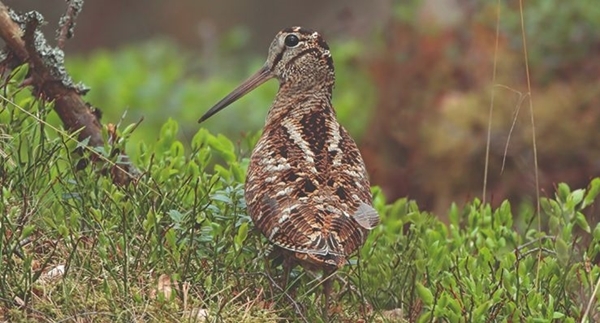
We have recently published Conserving Our Woodcock, a new guide which turns 50 years of GWCT woodcock research into practical guidance on how to provide the varied habitat woodcock require. This blog is taken from the guide, which you can download in full here.
The GWCT advises all those who wish to shoot woodcock to exercise particular care and improve their knowledge of local populations, thus enabling the shoot to minimise their impact on resident birds.
Globally, the woodcock is secure and migrants to the UK are abundant. We do not believe that a ban on woodcock shooting would help recover our resident woodcock, in the long term, for three reasons. First, there is an indication, at a national scale, of a reduction in hunting pressure over the last 20 years, with many people deciding voluntarily that they no longer wish to shoot woodcock.
Second, a ban might remove the motivation for landowners to manage their woods in ways that will maintain suitable habitat for woodcock. Third, parts of western Britain have no history of breeding woodcock, but host large numbers of migrants, so shooting in these areas does not put residents at risk except during cold spells when residents might move south and west.
The most recent estimate for the number of woodcock shot during the winter in the UK stands
at 140,000 (120-170,000)23. In Europe, it is believed the largest numbers of woodcock are shot in France, Greece, and Italy. An estimated 144,099 birds are shot every winter in Italy24 and over a million woodcock are thought to be shot in France annually.
So far, there is little indication that current levels of hunting are influencing the trend in the woodcock’s population on a European scale, but GWCT intend to improve our understanding of this with upcoming studies. It is important that the possible impacts on resident populations are considered separately because these populations are known to be undergoing declines. Declines in resident woodcock may be driven by low breeding success, most likely arising from change in habitat quality or rates of nest and chick predation, but these populations will then be less resilient to additional losses associated with shooting.
Until we better understand the reasons for the decline in our breeding woodcock and the effects of shooting, we believe it would be prudent for those that intend to shoot woodcock to:
1. Avoid shooting woodcock early in the season
Although migrant woodcock begin to arrive in October and November, at most sites across the UK numbers continue to build throughout the autumn/winter and do not peak until December. Delaying shooting until the majority of these migrants, that originate from stable continental populations, have arrived reduces the risk of any possible impact to vulnerable resident populations. Beginning shooting after the 1 December provides a useful rule of thumb.
2. Improve their understanding of their local woodcock populations before shooting
We advocate improving local knowledge about both the presence of resident breeders and
the numbers of woodcock typically present at different times during the winter. Roding counts can be used to detect breeding woodcock where they occur, and over several years provide an indication of local population trends.
In autumn/winter, a gradual increase in the frequency of woodcock sightings helps track the arrival of migrants and indicates the safest time to begin shooting (see above). This might be judged by counts of flighting woodcock at dusk, flush counts during autumn pheasant drives or seen at night during predator control activities. At most sites, migrants will vastly outnumber residents, providing a noticeable change in abundance once migrants have arrived. Information and survey forms can be found here.
3. Show restraint even where resident birds are absent
Restraint when shooting woodcock makes sense even in areas where there are no local breeders, because we know from our satellite tracking and annual ringing of woodcock that the majority of migrant woodcock are extremely faithful to the same wintering site year on year. Overshooting will therefore break the migratory link with your shoot and is likely to lead to fewer woodcock being seen in future.
4. Shoot flight lines with caution
Shooting woodcock flighting from woodland at dusk carries a higher risk of overshooting. We advise gauging woodcock numbers across known flight lines first and then deciding on a bag, preferably only targeting half the flight lines once per season.
5. Curb shooting in freezing weather
We have conducted research to understand the effect of cold weather on woodcock. Every effort should be made to reduce additional mortality when woodcock are at higher risk of starvation and predation during freezing spells. We are aware that most shoots stop shooting woodcock before a statutory cold weather suspension comes into force after 13 days.
Our current advice is that shooters should stop shooting woodcock after four days of frozen conditions and allow the birds at least seven days to recover after the end of the cold period before shooting recommences.